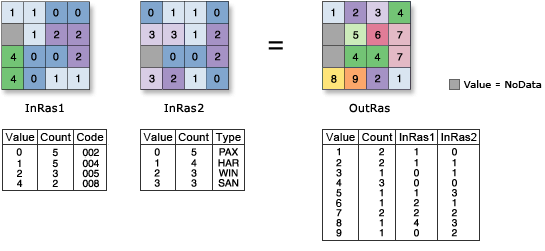This example takes several input rasters in different formats (Grid, IMG, and TIFF) and outputs the unique combination values as a Grid raster.
# Name: Combine_Ex_02.py
# Description: Combines multiple rasters such that a unique value is
# assigned to each unique combination of input values
# Requirements: Spatial Analyst Extension
# Import system modules
import arcpy
from arcpy import env
from arcpy.sa import *
# Set environment settings
env.workspace = "C:/sapyexamples/data"
# Set local variables
inRaster01 = "filter"
inRaster02 = "zone"
inRaster03 = "source.img"
inRaster04 = "dec.tif"
# Execute Combine
outCombine = Combine([inRaster01,inRaster02,inRaster03,inRaster04])
# Save the output
outCombine.save("C:/sapyexamples/output/outcombine")
